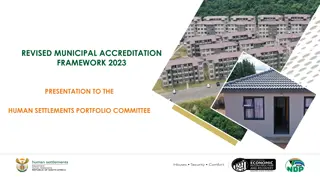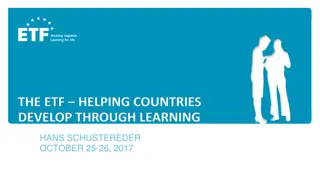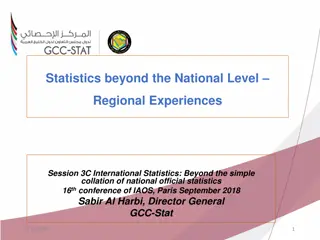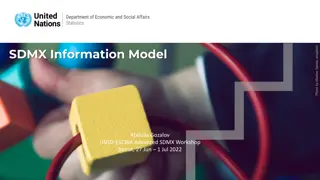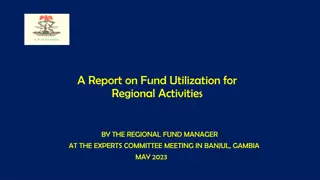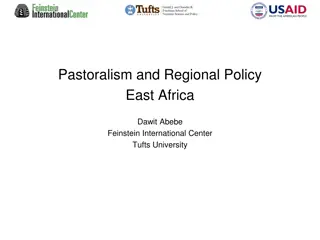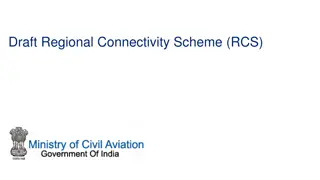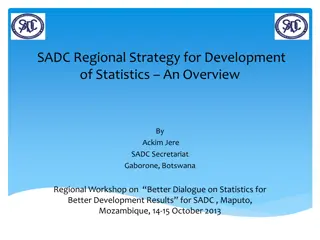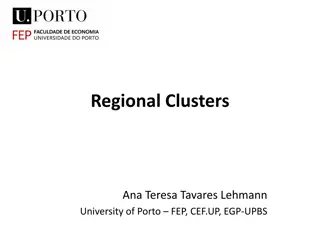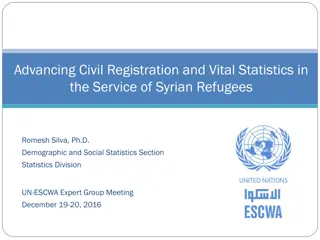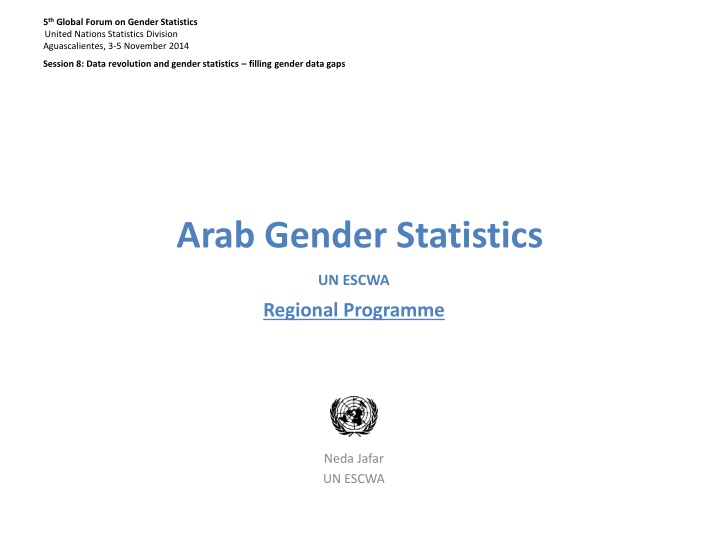
Gender Statistics Frameworks and Guidelines for Data Revolution
Explore the evolution and importance of gender statistics frameworks, user-producer dialogue, and data availability assessments in the UN ESCWA Regional Programme. Learn about developing, maintaining, and assessing gender data frameworks to fill gaps and drive policy decisions.
Download Presentation

Please find below an Image/Link to download the presentation.
The content on the website is provided AS IS for your information and personal use only. It may not be sold, licensed, or shared on other websites without obtaining consent from the author. If you encounter any issues during the download, it is possible that the publisher has removed the file from their server.
You are allowed to download the files provided on this website for personal or commercial use, subject to the condition that they are used lawfully. All files are the property of their respective owners.
The content on the website is provided AS IS for your information and personal use only. It may not be sold, licensed, or shared on other websites without obtaining consent from the author.
E N D
Presentation Transcript
5th Global Forum on Gender Statistics United Nations Statistics Division Aguascalientes, 3-5 November 2014 Session 8: Data revolution and gender statistics filling gender data gaps Arab Gender Statistics UN ESCWA Regional Programme Neda Jafar UN ESCWA
Background Gender Programme since 1997 1997-2006 compiling & disseminating sex-disaggregated data & gender indicators Arab countries produced W&M In 2006 shift with the first IAEG-GS for Arab countries ESCWA Gender Programme evolves in response to the national, regional and global needs Focus on concrete outcomes Combine practice with theory
UN ESCWA Regional Programme Glossary of gender terms 2011-2013 User-producer dialogue IAEG GS 2006 - 2015 Regional GS 3D Framework 2009 Assessment of data availability 2010-12 Revision of regional GS framework 2014-15 National GS Frameworks 2014-2017 Glossary of gender terms 2011-2013 Gender Statistics Framework Gender in MDGs 2009 Regional Metadata Handbook 2012-13 VAW Tool kit -manual 2012 Time Use Statistics- knowledge sharing site Guidelines for Developing GS Frameworks 2014 Gender in MDGs 2009 Regional Metadata Handbook 2012-13 VAW Tool kit -manual 2012 Time Use Statistics- knowledge sharing site Guidelines for Developing GS Frameworks 2014 Guidelines G2G Analysis 2015 Gender in Policy Regional Metadata Handbook 2012-13 VAW Tool kit -manual 2012 Time Use Statistics- knowledge sharing site Guidelines for Developing GS Frameworks 2014 Technical Guidelines Gender in Figures 2011-13 Dashboard 2013 Gender in Figures 2011-13 Dashboard 2013 Gender in Figures + Analysis 2014 -15 Country Profiles 2015 National GS Databases 2015 -2016 Data Capacity Building
UN ESCWA Regional Programme User-producer dialogue IAEG GS 2006 Regional GS 3D Framework 2009 Assessment of data availability 2010-12 Revision of Framework 2014 National GS Frameworks 2014-15 Gender Statistics Framework
Guidelines Gender Statistics Framework (a) Importance of a framework Framework Maintenance (b) Developing a framework (c) Selecting indicators (d) Assessing quality & relevance (e) Maintenance
Arab GIsIn Framework 2006 IAEG GS discussed proposed framework, 2009 published ARAB GS FRAMEWORK 2014 Revised GS FRAMEWORK 3D customized localized framework -links MDGs with 12 areas of BPoA Based on regional priority issues Quantitative & Qualitative indicators
Comprehensive framework that meets the monitoring and reporting requirements at all levels. Framework includes 107 indicators Quantitative &Qualitative 92 quantitative indicators 50 indicators available (Tier I); 17 indicators to be made available in near future (Tier II), 25 indicators to be collected using new tools (Tier III) 15 qualitative indicators available (Tier I) Update yielded Addition of new indicators Deletion of some indicators 12 Domains ; including 3 not in Global framework Women in armed conflict Women & environment Women and the media Includes indictors on poverty and hunger not in Global framework
Tiers Available and disseminated Tier I Available , not disseminated or calculated Tier II Not available, requires new tools to collect Tier III
Aligning ESCWA with Global Framework, 2014 UNSD GIsIn ESCWA Regional Minimum Set of GS Indicators Quantitative Tier III Tier I Tier II Economy, poverty and hunger Hunger x 1.4.1 Prevalence of underweight children under- five years of age, in percentage All x 1.4.2 Women and men below minimum level of dietary energy consumption, in percentage All Qatar Economy 1 Tier II 3.1.8 Average number of hours spent on unpaid domestic work by sex (Note: separate housework and child care if possible) Palestine, Tunis, Morocco, Qatar, Iraq, Oman All 2 Tier II New Average time ( number of hours) spent on paid and unpaid (domestic work and caring for children and elderly) combined (total work burden) Palestine, Tunis Morocco, Qatar, Iraq, Oman, SA All 3 Tier I New Labor force participation rate for persons aged 15-24 and 15+, (economic activity rate) 15+, in percentage All
Regional Minimum Set of GS Indicators Domain Sub-domain Tier I Tier II Tier III Economy, poverty and hunger Poverty Hunger Economy 29 6 2 21 12 6 4 11 2 2 10 2 9 Education and literacy Health 15 21 15 11 6 4 Public life, decision-making, and empowerment Human rights (women and girl child) Environment Media Women in armed conflict Total Quantitative Total Qualitative Total 9 8 1 12 4 8 2 2 2 2 2 2 92 50 15 65 17 25 82
National Gender Statistics Framework National documents W&M, CEDAW, STRATEGY Phase I Regional / Global indicators and Gender in Figures national indicators Phase II Phase III Revision and consultation process to finalize the framework
Status of National Gender Statistics PHASE I PHASE II PHASE III DATABASE Bahrain Egypt Iraq Jordan Lebanon Oman Palestine Qatar Tunisia Sudan Morocco UAE
Celebrate Success Stories e-Cataloge of Gender Statistics Promote good national practices Provide useful information on development stage Plan future capacity building activities Publications Gender Databases & Web Surveys Meetings Advocacy
Thank You Thank You


